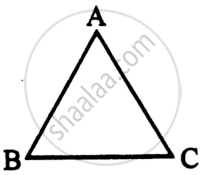Advertisements
Advertisements
प्रश्न
The energy of photon of wavelength X is_____ .
[h = Planck’s constant, c = speed of light in vacuum]
विकल्प
hcλ
`(hλ)/c`
`λ/(hc)`
`(hc)/λ`
उत्तर
`(hc)/lambda`
Energy of a photon E =`hv=(hc)/lambda`
APPEARS IN
संबंधित प्रश्न
The momentum of a photon of de Broglie wavelength 5000Å is _______.
[Planck’s constant = 6.63 x10-34 J.s.]
When radiations of wavelength λ1 and λ2 are incident on certain photosensitive, such that E1 > E2 . Then Planck's constant 'h' is ......................... .
(C = Velocity of light).
The photoelectric threshold wavelength of a metal is 230 nm. Determine the maximum kinetic energy in joule and in eV of the ejects electron for the metal surface when it is exposed to a radiation of wavelength 180 nm.
[Planck’s constant : h = 6.63 * 10-34 Js, Velocity of light : C = 3 * 108 m/s.]
Find the wave number of a photon having energy of 2.072 eV
Given : Charge on electron = 1.6 x 10-19 C,
Velocity of light in air = 3 x 108 m/s,
Planck’s constant = 6.63 x 10-34 J-s.
A proton and a deuteron are accelerated through the same accelerating potential. Which one of the two has less momentum?
Give reasons to justify your answer.
The work function for a metal surface is 2.2eV. If the light of wavelength 5000Å is incident on the surface of the metal, find the threshold frequency and incident frequency. Will there be an emission of photoelectrons or not? (c = 3 x 108 m/ s, 1eV = 1.6x10-19 J , h = 6.63 x 10-34 J.s.)
Einstein's photoelectric equation is:
a) `E_"max" = hlambda - varphi_0`
b) `E_"max"= (hc)/lambda varphi_0`
c) `E_"max" = hv + varphi_0`
d) `E_"max" = (hv)/lambda + varphi_0`
Write Einstein’s photoelectric equation.
According to Einstein’s model minimum energy needed for the electron to escape from a metal surface having work function ϕ0, the electron is emitted with maximum kinetic energy, Kmax = ______.
According to Einstein’s model, the threshold frequency for a metal having work function ϕ0 is given by _________.
According to the Einstein’s model, stopping potential Vo for a metal having work function ϕ0 is given by ______.
Calculate the maximum kinetic energy of photoelectrons emitted by a metal (work function = 1.5 eV) when it is illuminated with light of wavelength 198 nm.
Plot a labelled graph of |Vs| where Vs is stopping potential versus frequency f of the incident radiation. State how will you use this graph to determine the value of Planck's constant?
In an inelastic collision, which of the following does not remain conserved?
According to Einstein's photoelectric equation, the plot of the kinetic energy of the emitted photoelectrons from a metal Vs the frequency of the incident radiation gives as straight the whose slope:
Dimensions of ‘resistance’ are same as (where h is Planck's constant and e is charge):
Einstein work on the photoelectric effect provided support for the eqn:-
Who indirectly determined the mass of the electron by measuring the charge of the electrons?
If the frequency of light in a photoelectric experiment is double the stopping potential will
Which of the following is/are true for cathode ray
The emission of electron is possible
(i) A ray of light incident on face AB of an equilateral glass prism, shows minimum deviation of 30°. Calculate the speed of light through the prism.

(ii) Find the angle of incidence at face AB so that the emergent ray grazes along the face AC.
- Calculate the frequency of a photon of energy 6.5 × 10−19 J.
- Can this photon cause the emission of an electron from the surface of Cs of work function 2.14 eV? If yes, what will be the maximum kinetic energy of the photoelectron?
Ultraviolet light is incident on metals P, Q and R, having work functions 8 eV, 2 eV and 4 eV respectively,
- Which metal has lowest threshold frequency for photoelectric effect?
- For which metal is the value of Emax minimum?
(Note: Emax is maximum kinetic energy of the emitted photoelectrons.)
How does stopping potential in photoelectric emission vary if the intensity of the incident radiation increases?
How does stopping potential in photoelectric emission vary if the frequency of incident radiation decreases?
